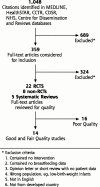The effectiveness of primary care-based interventions to promote breastfeeding: systematic evidence review and meta-analysis for the US Preventive Services Task Force
- PMID: 15040435
- PMCID: PMC1466575
- DOI: 10.1370/afm.56
The effectiveness of primary care-based interventions to promote breastfeeding: systematic evidence review and meta-analysis for the US Preventive Services Task Force
Abstract
Purpose: We wanted to systematically review whether primary care-based interventions improve initiation and duration of breastfeeding.
Methods: Studies were found by searching MEDLINE (1966-2001), Health-STAR, the Cochrane Database of Systematic Reviews, the National Health Service Centre for Reviews and Dissemination Databases, and bibliographies of identified trials and review articles. Studies were included if they originated in the primary care setting and were conducted in a developed country, written in English, and contained a concurrent control group.
Results: Thirty randomized and nonrandomized controlled trials and 5 systematic reviews of breastfeeding counseling were included. Educational programs had the greatest effect of any single intervention on both initiation (difference 0.23; 95% confidence interval [CI], 0.12-0.34) and short-term duration (difference 0.39; 95% CI, 0.27-0.50). Support programs conducted by telephone, in person, or both increased short-term (difference 0.11; 95% CI, 0.03-0.19) and long-term duration (difference 0.08; 95% CI, 0.02-0.16). In contrast, written materials such as pamphlets did not significantly increase breastfeeding. Data were insufficient to determine whether the combination of education with support was more effective than education alone.
Conclusions: Educational programs were the most effective single intervention. One woman would breast-feed for up to 3 months for every 3 to 5 women attending breastfeeding educational programs. Future research and policy should focus on translating these findings into more widespread practice in diverse primary care settings.
References
-
- Kramer MS, Chalmers B, Hodnett ED, et al. Promotion of Breastfeeding Intervention Trial (PROBIT): a randomized trial in the Republic of Belarus. JAMA 2001;285(4):413–420. - PubMed
-
- Kennedy KI, Visness CM. Contraceptive efficacy of lactational amenorrhoea. Lancet 1992;339(8787):227–230. - PubMed
-
- Heinig MJ, Dewey KG. Health effects of breast feeding for mothers: a critical review. Nut Res Rev 1997;10:35–56. - PubMed
-
- U.S. Department of Health and Human Services. Healthy People 2010. Available at: http://web.health.gov/healthypeople/document/html/volume2/22physical.htm. 2000. Accessed June 25, 2003.
-
- Ryan AS, Wenjun Z, Acosta A. Breastfeeding continues to increase into the new millennium. Pediatrics 2002;110(6):1103–1109. - PubMed

